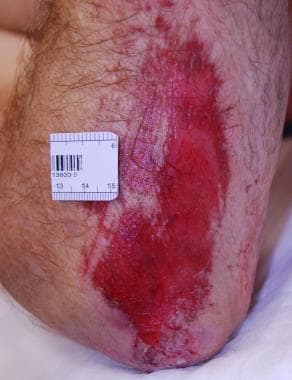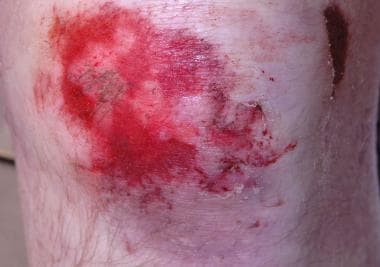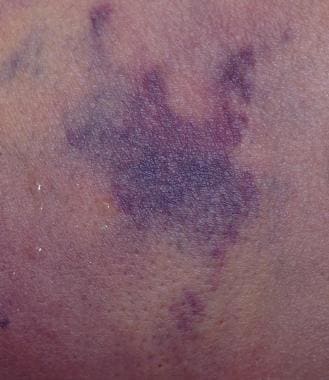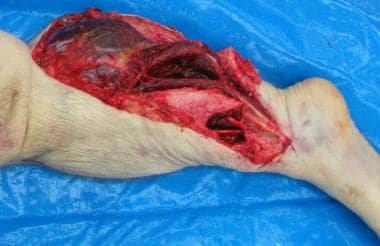
Deaths resulting from blunt force trauma are some of the most common cases encountered by the practicing forensic pathologist. Whereas other forms of traumatic death (eg, gunshot wounds, sharp force injuries) occur under a relatively limited number of circumstances, deaths resulting from blunt force trauma occur in a variety of scenarios. For instance, almost all transportation fatalities—including those involving motor vehicle collisions, pedestrians being struck by vehicles, airplane crashes, and boating incidents—result from blunt force trauma. Other deaths resulting from blunt force trauma involve jumping or falling from heights, blast injuries, and being struck by a firm object, such as a fist, crowbar, bat, or ball. Bite wounds and chop injuries may be considered variants of blunt force trauma, sharp force trauma, or a class of injuries unto themselves.
Blunt force trauma is routinely involved in cases classified as accidents, as well as in cases of suicide and homicide. People dying natural deaths often have minor blunt force injuries that do not contribute to death—small abrasions or contusions on the skin are commonplace at autopsy. Although it is important to document evidence of blunt force trauma in all autopsies, one should not immediately assume that blunt force trauma is the cause of death.
For purposes of death certification, it should be noted that blunt force trauma may be the underlying (proximate) cause of death in cases in which the immediate cause of death is a natural disease process. For example, individuals may die of infections, thromboemboli, or organ failure that occurs as a delayed result of previous blunt force trauma. In some cases, the injury may have occurred many years before death.
It is important to understand that the designated manner of death in such scenarios must include the causal factor that made the decedent susceptible to the disease state, namely the underlying injury which initiated the chain of events ultimately leading to death. For example, the cause of death of an individual who dies of pneumonia after being hospitalized for several days for treatment of blunt force injuries following a motor vehicle collision should be certified as "acute bronchopneumonia complicating blunt force injuries due to a motor vehicle accident." The manner of death should then be certified as "accident."
This chapter focuses on the cutaneous manifestations of blunt force injury. Other chapters will expand on topics such as closed head injuries, including sequelae of rapid acceleration/deceleration.
The severity of injuries inflicted as a result of blunt force trauma is dependent on the amount of kinetic energy transferred and the tissue to which the energy is transferred. The kinetic energy associated with a moving object is equal to one half the mass of that object multiplied by the velocity of the object squared (1/2 mv 2 ). In general, a somewhat lighter object traveling at high speed will cause more damage than a heavier object traveling at low speed. [1, 2, 3, 4]
Equally important, however, are the characteristics of the blunt object and the surface that is impacted. Impacts involving a large surface area—either with regard to the impacting object or with regard to the tissues being impacted—will result in a greater dispersion of energy over a larger area and less injury to the impacted tissues. For example, a thin metal pipe striking some part of the body would be expected to inflict greater localized injuries than a broad board of similar mass and velocity striking the same part of the body. Likewise, an impact on a small area of a curved surface, such as the head, will cause greater damage than would be caused were that same impact to occur on a flat surface, such as the back, since there will be a more concentrated point of impact on the head.
The composition, or plasticity, of the tissues impacted also affects the resultant injuries. For example, a person who is kicked in the chest may have only minimal injuries to the elastic skin surface, whereas deeper, more solid tissues such as ribs and internal organs (notably, the spleen and liver) may experience fractures and lacerations.
Yet another factor affecting the severity of blunt force injuries is the amount of time the body and the impacting object are in contact. A longer period of contact allows kinetic energy to be dissipated over a prolonged period, resulting in less damage to the tissues than an equally forceful impact with dispersion of energy over a brief period.
A report by the Centers for Disease Control evaluated violent deaths occurring in 39 states, the District of Columbia, and Puerto Rico during the year 2018. In the report, a "violent death" is defined as a death resulting from the intentional use of physical force or power against oneself, another person, or a group or community. [5] Blunt force trauma accounted for 4.2% of all homicides, compared with the top two means of homicide: firearms (71.5%) and sharp instrument (10.6%). [5] Blunt force trauma accounted for less than 1% of all suicides. [5]
Blunt force trauma: Injuries resulting from an impact with a dull, firm surface or object. Individual injuries may be patterned (eg, characteristics of the wound suggest a particular type of blunt object) or nonspecific. Although this article focuses mainly on external injuries, blunt force trauma may cause contusions and lacerations of the internal organs and soft tissues, as well as fractures and dislocations of bony structures. The major types of cutaneous blunt force injuries are as follows [6, 7] :
Abrasion: A scraping injury to the superficial layers of the skin (epidermis and dermis) that results from friction against a rough surface (see the following images)

--> Forensic Autopsy of Blunt Force Trauma. Abrasion on the elbow.

--> Forensic Autopsy of Blunt Force Trauma. Abrasion on the knee.
Contusion (bruise): Hemorrhage into the dermis, subcutaneous tissues, deep soft tissues, and internal organs as a result of rupture of blood vessels following impact with a blunt object or surface (as shown below).

--> Forensic Autopsy of Blunt Force Trauma. Two contusions on the skin of the chest.

--> Forensic Autopsy of Blunt Force Trauma. A contusion on the arm.

--> Forensic Autopsy of Blunt Force Trauma. Cross section of brain with cerebral contusions on the inferior surface.
Laceration: A bursting of the skin or other tissues resulting from compression or stretching associated with impact by a blunt object or surface (see the following images).

--> Forensic Autopsy of Blunt Force Trauma. Two abraded lacerations on the forehead.

--> Forensic Autopsy of Blunt Force Trauma. A laceration near the vertex of the scalp.
Avulsion: A more severe form of laceration in which the soft tissues, musculature, and/or bone are torn away from the normal points of attachment (as seen in the image below).

--> Forensic Autopsy of Blunt Force Trauma. Avulsion of the right leg.
Fracture: A break, rupture, or separation of tissue (most often bone) resulting from an impact (see the following image).

--> Forensic Autopsy of Blunt Force Trauma. Extensive fractures involving the base of skull.
These injuries are often seen in combination with one another. For example, abrasions are often found at the margins of lacerations. Abrasions, lacerations, and contusions are often noted adjacent to fractures.